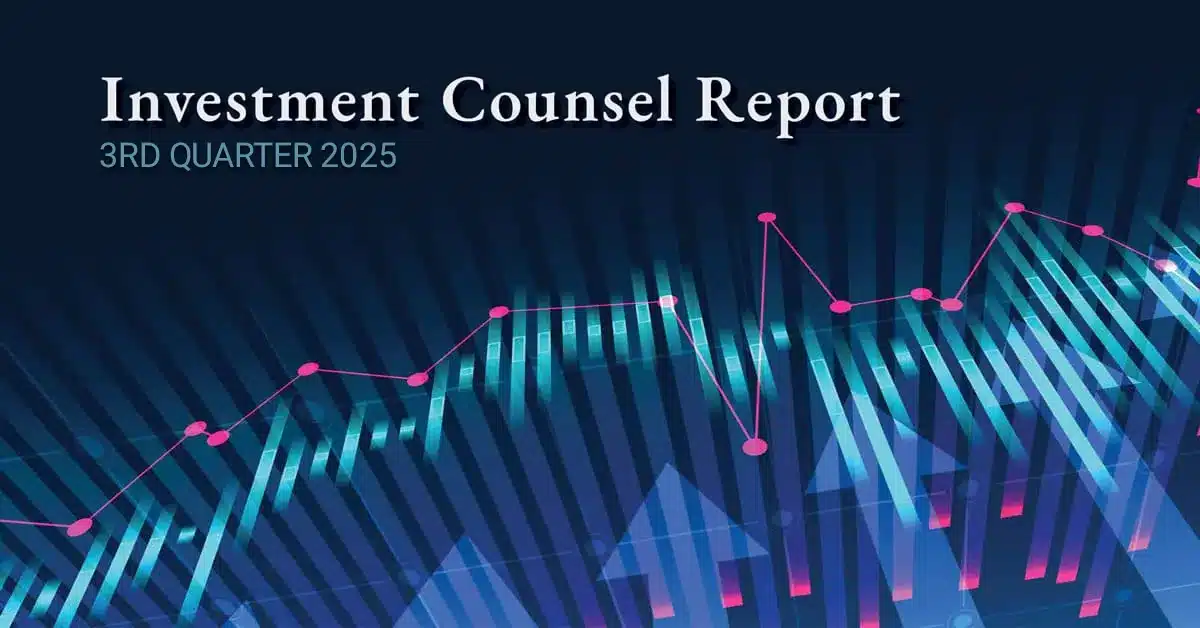A nearly full reversal of the first quarter of 2025 occurred in the second quarter – with larger stocks snapping back from a moderate swoon. Large stocks of the S&P 500 Index rose 10.9% in Q2, 25, standing at +6.2% for the Year To Date through June 30th.

Market Summary
Despite ongoing geopolitical uncertainty and concerns over trade tariffs, broad market averages moved higher over the past three months.
The large stocks of the S&P 500 Index rode technology stock strength and rose +8.1% in the third quarter of 2025. This continued a recovery from early weakness in the year, and the Index stands at +14.8% for the Year To Date. The smaller companies of the Russell 2000 Index spiked higher and returned +12.4% in the quarter. For the Year To Date smaller stocks are trailing larger stocks with a +10.3% return, highlighting the strength of the large cap tech rally.
Foreign stocks that comprise the EAFE Index rose a more moderate +4.9% for the quarter, and have enjoyed a massive +25.8% performance YTD.
Aurora Perspective
While the positive absolute returns for the beginning of 2025 are helpful to advancing our clients’ Investment Policy growth goals, relative performance has been lagging some market sectors. This condition is always frustrating and thankfully hasn’t been the case over long periods of time. Examining our current holdings and their fundamental financial traits, there is very little that has changed in relation to our Growth At a Reasonable Price approach. Having invested over many intermediate cycles of the stock market and economy in our discipline’s 30 year history, there are some echos that are consistent with current conditions.
Two dominant themes that presently explain much of the stock market’s excess rewards are Artificial Intellegence and the myriad opportunities this technology offers, and the large piles of money made available through private credit vehicles and intermediaries. While there is not enough space here to denote much detail regarding these aspects, suffice to say that there are examples in stock market history where similar backdrops and excess have reversed in sharp and painful unwinding.
Comparisons of the Internet Age in the Year 2000 seem apt – optimistic returns that showered rewards to companies well in advance of revenues and cash flows associated with the new technology. This extended not just to the software/tool developers (Amazon, Yahoo, AOL, etc.), but also to the “picks and shovels” purveyors (Cisco, Corning, WorldCom, etc.). AI may be driving a unique technological revolution, but it’s not hard to find echoes of similar market conditions and stock behavior today.
One potential chink in this story today is that the absolutely massive capital expenditures to build out AI services (picks and shovels) are being financed by a very small cadre of check writers. This risk is also exacerbated by some “circular” funding between developers and infrastructure builders. OpenAI (model developer) has agreed to hundreds of billions of payments to Nvidia, Microsoft and Oracle, who in turn have co-invested in each other while also booking revenues associated with to-be-developed services. Everyone is paying each other to help build the field – with the assumption that future revenues will come.
The other comparison to prior periods that gives us pause is the free flow of easy credit available not just to these AI-related companies, but in many non-traditional economic corners. The flow and supply of credit is always in need of monitoring, and through the ages dramatic imbalances have been painfully undone. In today’s iteration, new intermediaries (hedge funds, private lenders) have been replacing traditional banks in delivering credit. This adds levels of obscurity, making it difficult to monitor conditions and identify possible risks. In prior credit meltdowns (CMO’s, CLO’s in the 90’s and toxic waste mortgages in 2007), the defaults exploded without much prior awareness to the problem because these “new” vehicles shrouded the issues from public awareness.
Today’s private credit intermediaries are similarly removed from scrutiny. There have recently been some surprises in defaults coming from these corners (TriColor, FirstBrands). Jamie Dimon of JP Morgan made some waves with a comment regarding private credit risks – “where we find one cockroach, there tends to be others”. Point being, the first signs of distress may be revealing themselves, and we might expect to see further stress exposed as time unfolds.
Aurora Outlook
Through our 30 years of maintaining Aurora’s investment discipline, there has always been a wall of worry and risks that must be navigated in the pursuit of long term growth. We have been through enough to be wary and vigilant to conditions that disrupt the stock market and challenge the profitability of our individual company holdings. We have tended to avoid the “hottest” sectors and fads, in favor of more consistent business models and fundamentals. We have typically lagged the broader market when little concern is given to risks created by conditions like we perceive in AI and private credit.
Beneficially though, Aurora’s approach has allowed our clients to receive very healthy absolute returns over the long term. We have also been able to lighten and avoid the deepest drawdowns when prior imbalances and bubbles have burst. By ensuring that the companies we invest in have earnings growth, adequate cash flow and funding, and whose stock prices exhibit cheapness – the external excesses can be mitigated. In summary, absolute returns of late are adequate to advance our clients’ growth goals. Short term underperformance is frustrating and typically temporal, but a bearable price to avoid some of the overheated areas of excess and risk.
